Championship Auto Racing Teams
Championship Auto Racing Teams (CART) was a sanctioning body for American open-wheel car racing that operated from 1979 to 2003. It sanctioned the PPG Indy Car World Series from 1979 until dissolving after the 2003 season.
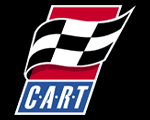 | |
| Category | American Open Wheel |
|---|---|
| Country | United States, Canada |
| Inaugural season | 1979 |
| Folded | 2003 |
CART was founded in 1979 by United States Auto Club (USAC) Championship Division team owners who disagreed with the direction and leadership of USAC, with the then-novel idea of car owners sanctioning and promoting their own series collectively instead of relying on a neutral body to do so. Through the 1980s, the Indy Car World Series became the pre-eminent open-wheel auto racing series in North America, featuring street circuits, road courses, and oval track racing. CART drivers continued to compete at the USAC-sanctioned Indianapolis 500.
Even as the series prospered, concerns about costs, competitiveness, and revenue sharing began to create opposition to CART's organizational structure. Attempts at reform, which saw the company rebranded as IndyCar in 1992[1] and a compromise board formed, failed. In 1996, an open wheel "split" saw the newly created Indy Racing League (IRL) take full control over the Indianapolis 500 and start a competing oval-based open-wheel series. CART ceased using the IndyCar name but continued its series without participating in the Indianapolis 500.
The "split" saw a dramatic fall in general interest for open wheel racing in the United States, which was compounded by the growing popularity of NASCAR, creating a downward trend in sponsorship and attendance at some tracks. After a series of setbacks in the early 2000s saw the departure of major racing teams and engine manufacturers to the IRL, CART went bankrupt at the end of the 2003 season.
In 2004, a trio of team owners acquired the assets of the series from bankruptcy, renaming the series Champ Car. Continuing financial difficulties caused Champ Car to file for bankruptcy before its planned 2008 season; its assets and history were merged into the IRL's IndyCar Series, reuniting both series of American open-wheel racing.
Vehicles
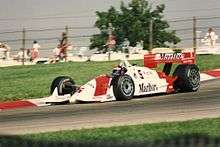
Champ Cars (before 1997, advertised as IndyCars) were single-seat, open-wheel racing cars, with mid-mounted engines. Champ cars had sculpted undersides to create ground effects and prominent wings to create downforce. The cars would use different aerodynamic kits depending on whether they were racing on an oval or a road-course.
Teams typically purchased chassis constructed by independent suppliers such as Lola, Swift, Reynard, and March, with some owners, such as Dan Gurney and Roger Penske, constructing their own. The series exclusively used Goodyear tires until 1995, when Firestone entered, creating a spirited competition between the brands. Firestone ultimately became the exclusive supplier in 2000, with their parent company Bridgestone taking over the role in 2003.
Champ Cars used turbocharged engines that ran on methanol fuel. Cosworth (branded as Ford), Ilmor (branded as Chevrolet), and Buick engines were common until the mid-1990s, which saw Mercedes-Benz take over as Ilmor's branding and Honda and Toyota enter factory efforts. Engines were typically leased from manufacturers, who conducted research and development during the racing season; one engine could easily dominate competition in the first part of the season and then fall behind. The exclusive availability of more advanced versions of engines to certain teams in the early-1990s became a major source of contention within the organization, and manufacturers fiercely resisted proposals to have engines simply be purchased by teams. In 2003, after the withdrawal of Honda and Toyota, CART purchased a series of identical 2.65L V-8 turbocharged Cosworth engines and leased them to teams under Ford branding.
Champ Cars were visually similar, and often compared to, Formula 1 cars, which also featured wings, mid-engines, and an open-wheel design. Due to their use on ovals, Champ Cars weighed more and were more substantial in size, but typically had more powerful engines. Both series tended to downplay comparisons for commercial reasons, but 2002 saw a rare occurrence in both series running the same track (Circuit Gilles Villeneuve in Montreal) within a month of each other. Juan Pablo Montoya won the pole position for the Formula One race with a lap time of 1'12.836, with the slowest being Alex Yoong's 1'17.34; Several weeks later, Cristiano da Matta won the pole position in a Champ Car race with a lap time of 1'18.959.
History
Foundation

In 1905 the AAA established a national driving championship and became the first sanctioning body for auto racing in the United States. The AAA ceased sanctioning auto racing in the general outrage over motor racing safety that followed the 1955 Le Mans disaster. In response, Indianapolis Motor Speedway president Tony Hulman formed the United States Auto Club (USAC) to take over the sanctioning of what was called "championship" auto racing, or open wheel racing, whose biggest event was the annual Indianapolis 500 at the Indianapolis Motor Speedway. USAC sanctioned the championship exclusively until 1978, and was the Fédération Internationale de l'Automobile's recognized American authority with regard to open wheel racing.
Competitors in the championship circuit, coalescing around Dan Gurney, began to become critical of USAC's sanctioning though the 1970s. Notable incidents included the loss of a lucrative sponsorship by Marlboro in 1971 after USAC failed to enforce the brand's exclusivity at events, the existence of dirt tracks, purses that teams said would result in a loss in money even if the team made the podium, and a lack of modern promotion for the non-Indianapolis events in the series.
In early 1978, Gurney wrote what came to be known as the "Gurney White Paper", the blueprint for an organization called Championship Auto Racing Teams.[2] Gurney took his inspiration from the improvements Bernie Ecclestone had forced on Formula One with his creation of the Formula One Constructors Association. The White Paper called for the owners to form CART as an advocacy group to promote USAC's national championship. The group would also work to negotiate television rights, sponsorship agreements, and race purses, and ideally hold seats on USAC's governing body. In 1978, the last season that USAC was sole sanctioning body for Championship racing, their 18 race schedule had 4 road course races and 14 oval track races.
On April 23, 1978, eight top USAC officials died in an airplane crash, creating an organizational vacuum that severely hampered the 1978 season. In November 1978 Gurney, joined by other leading team owners including Roger Penske and Pat Patrick, took their requests to USAC's Board, but the proposal was rejected, leading to the creation of a new stand-alone series The first CART race was held in March 1979, with the Sports Car Club of America sanctioning the series.
USAC initially tried to ban all CART drivers from the 1979 Indianapolis 500, informing CART teams by telegram during their event at Atlanta Motor Speedway, until CART succeeded in obtaining an injunction to allow its cars to qualify.[3] Of the 20 races held in 1979, 13 were part of the 1979 CART Championship. An attempt by USAC and CART to jointly sanction races in 1980 as the Championship Racing League saw USAC withdraw after 5 races, and by the end of 1981 the only USAC sanctioned asphalt championship race was the Indianapolis 500.
CART PPG Indy Car World Series (1982–1991)
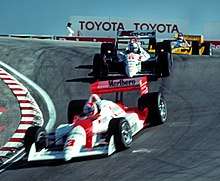
By 1982, the CART PPG Indy Car World Series was universally recognized as the American national championship in open wheel racing. In 1983, USAC agreed to allow CART to add the Indy 500 to its schedule and have drivers be awarded points in the CART championship in return for retaining the authority to sanction the 500. Beginning with a schedule mainly based on oval speedways like its USAC predecessor, the series began to move into prominent North American road racing circuits such as Road America, Mid-Ohio, and Laguna Seca, replacing the declining Can-Am series. Many racing stars, including Mario Andretti, Bobby Rahal, and Danny Sullivan found success in CART, which by the mid-1980s moved into sanctioning street races, taking over the Detroit Grand Prix and the Grand Prix of Long Beach from Formula One, and expanding to Toronto and Cleveland. CART founded the first full-time driver safety team that traveled with the series, instead of depending on local staff provided by promoters.
For the first time, open-wheel racing outside of Indianapolis had developed a stable schedule, enabling more generous sponsorship and television opportunities for the owners. Despite the corresponding increases in attendance, TV revenue, and purses, CART's egalitarian governing structure created its own headaches. CART owners were incredibly diverse: For example, owners such as Carl Haas and Roger Penske owned speedways and had generous contracts with tire, chassis, and engine manufactures, while other teams simply purchased older cars and ran the races they could afford to attend. The diversity of interests led to annual fights and accusations of real and apparent conflicts of interest with regard to rules, sponsorship, driver safety, track selection, and other matters.
In 1988, CART joined ACCUS, allowing foreign drivers to compete without risking their FIA superlicenses.[4] This, combined with former F1 champion Emerson Fittipaldi's series title in 1989, attracted drivers from South America and Europe to join what had previously been a mostly American dominated series. A growing contingent of international drivers helped make the series a valuable television property for growing sports cable networks worldwide. CART would host its first race outside North America, in Surfer's Paradise, Australia, in 1991.
IndyCar and the "Split" (1992–1996)
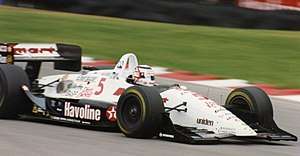
As the larger teams and engine and chassis manufactures competed for victories, costs were rapidly increasing, pricing out smaller teams. Tony George, by 1989 the president of the Indianapolis Motor Speedway (IMS), and others viewed foreign drivers and street circuits as discouraging USAC American sprint racing talent, such as Indiana driver Jeff Gordon, from competing in IndyCars.[5] NASCAR, which ran predominantly on ovals, was gaining in popularity in IndyCar's traditional Midwestern US market.
CART was regularly accused of serving only the interest of team owners, especially the richest ones, and not of the sport as a whole. CART owners believed that the teams, who took the most risks, paid the drivers, and expended the most cash, should control the general direction of the sport. CART owners also resented George, and felt that his close relationship with USAC meant he could jeopardize the series' involvement in the Indianapolis 500 on a whim. Debate continued for a number of years over the proper oversight mechanism for the sport, with IMS resisting any revenue sharing or control over Indianapolis and owners not wanting to give too much power to track promoters. In an attempt to address these concerns, in 1992, CART rebranded as IndyCar, and later in 1992 formed a compromise board with owners electing five members with voting rights, with the IndyCar CEO (representing the other owners) and George (representing IMS) having non-voting seats.
1993 would see British driver Nigel Mansell, the 1992 F1 Driver's Champion, switch to IndyCar and beat Fittipaldi for the championship. The new board collapsed at the end of the season after a series of controversial decisions, mainly shutting out Japanese manufacturers, cancelling a planned race at Brands Hatch in the United Kingdom, and keeping the schedule exactly the same, that were seen as driven by conflicts of interest of George and the five owners elected to the new board.[6]
In March 1994, George announced his resignation from the IndyCar board. That year, Team Penske introduced a Mercedes-Benz engine specifically designed for the 1994 Indianapolis 500 that exploited a rule difference between the USAC and IndyCar, dominating the race and prompting fears that costs would continue to grow out of control.[7] In July, IMS announced the founding of the Indy Racing League, which would be cost controlled and race solely on American ovals and be sanctioned by USAC.[8]

After the 1995 Indianapolis 500 saw driver complaints about USAC's oversight, George announced that for the 1996 Indianapolis 500 the top 25 drivers in IRL points would be guaranteed a spot in the race, leaving only eight of the 33 grid positions available to others. This was known as the "25/8 Rule,"[9] and was unprecedented, as the 500 had traditionally always put every spot up for open qualification.[9] CART declared they had been locked out of the event and would no longer race at Indianapolis, while George declared that CART was boycotting.[10] To placate sponsors who contractually required the accommodation of large contingents to attend Indianapolis, CART created a rival showcase event, the U.S. 500, at Michigan International Speedway on the same day as the Indy 500 in 1996.[10] In March, Indianapolis Motor Speedway attempted to terminate CART's license to their "IndyCar" trademark in Federal Court.[11]
The lead-up to Memorial Day 1996 saw a public relations war, pitting the owners and drivers of CART against George and IMS. Michael Andretti publicly stated that allowing the IRL regulars to run the race and compensating by increasing turbo boost would provoke injury, calling it "unconscionable."[12]
The 1996 Indianapolis 500 did see a series of accidents, with a quarter of the race run under caution before Buddy Lazier won his first race.[12] The US 500, starting halfway through the Indy 500, had a disastrous start with a twelve-car crash, delaying the race for an hour.[12] Jimmy Vasser, who won by 11 seconds, quipped "Who needs milk?" while exiting his car for the podium, referring to the tradition of the Indy 500 winner drinking milk. Both at the time and in retrospect, the weekend was seen as a fiasco that began a serious decline in open-wheel racing, with both the Indy 500 and other Indycar events seeing drastic decline in prominence, TV viewership, and attendance.
CART FedEx Championship Series (1997–2000)
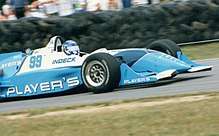
After a number of competing lawsuits, CART agreed to revert to their formal initialism following the 1996 season, on the condition that the IRL would not use the name before the end of the 2002 season.[13] CART began promoting its vehicles as "champ cars," a term that had previously been used by USAC's championship division.
In the early years after the launch of the IRL in 1996, CART was in a far stronger position: It held most of the prestigious races, sponsorship money, most of the "name" drivers and teams, and was the preferred series for manufacturers due to the IRL's ban on engine leases. IRL's primary asset was Indianapolis Motor Speedway and its 500. 1996 and 1997 saw generally well regarding racing with stars such as Jimmy Vasser, rookie sensation Alex Zanardi, and Michael Andretti leading the points standings, while the IRL experienced growing pains, including a rain-soaked 1997 Indianapolis 500, off-putting engine sounds from their new normally-aspirated engines, and the abandonment of USAC sanctioning due to incompetence.[14]
CART, in further contrast to IMS's sole ownership of the IRL, opted to proceed with a public stock offering, selling on the NASDAQ as stock symbol MPH. The offering raised US$100 million by selling 35% of the company. While this allowed CART to have sufficient cash reserves to expand and purchase the Indy Lights series, commentators suggested it was short-sighted to subject the notoriously secretive and fluctuating finances of the auto racing industry to public trading requirements. [15]
Efforts, led mostly by engine manufacturers, to pressure CART and the IRL to at least adopt uniform engine standards were met with a cold refusal from the IRL, which started to carve a niche in the motorsports landscape by leveraging close relationships with the new NASCAR spec ovals being built, with the series' substantial losses being underwritten by the other revenue streams of IMS.[16]
Despite the split, CART saw its annual revenues increase from $38,000,000 in 1995 to $68,800,000 by 1999, street races remained lucrative, and teams were able to make some gains on sponsorship revenues.[17] The success was uneven, as the series' traditional oval races in Michigan and Nazareth began to see dramatic attendance declines,[18] which CART blamed on substandard marketing.[19] Television ratings and revenue were anemic, with the series receiving $5,000,000 annually for the entirety of its television package, less than the rate for some individual NASCAR races.[20] While CART's stock was generally considered healthy, investors noted that the company's valuation tended to fluctuate with the perceived success or failure of IRL merger talks.[21]
CART's championship battle in 1999 between young stars Juan Pablo Montoya and Dario Franchitti was overshadowed by the deaths of drivers Gonzalo Rodríguez and Greg Moore within two months of each other. Moore's death at the 1999 Marlboro 500 especially raised serious concerns about safety in the 500 mile races conducted in Fontana and Michigan that saw Champ Cars average speeds of near 240 mph (390 km/h).
In 2000, in an attempt to recover domestic market share, CART owners forced Andrew Craig to resign as CEO, and popular driver/owner Bobby Rahal stepped in as interim CEO. One of his first acts was to replace the PPG Cup (used from 1979–1999) with the Vanderbilt Cup as the series championship trophy. Chip Ganassi, under pressure from his main sponsors, also persuaded the board to leave Memorial Day open on the schedule and returned to the Indy 500 with Vasser and Montoya. Montoya put on a dominating performance at Indy, leading 167 of the 200 laps to win. The Ganassi team's primary advantage was the greater engineering put into their IRL-spec car. 2000 would see Team Penske's return to prominence as Gil de Ferran won the driver's title.
Decline (2001–2003)
.jpg)
For 2001, CART unveiled their most ambitious schedule yet, with 22 races in the United States, Canada, Mexico, Brazil, Japan, the United Kingdom, Germany and Australia. The loss of Homestead-Miami and Gateway to the IRL was to be offset by the addition of Texas Motor Speedway, which had seen an exciting IRL race the year prior. Rahal retired to head Jaguar Racing in Formula 1, leading to marketing expert Joseph Heitzler taking the helm.[22]
Brazil was cancelled after track promoters defaulted. The race at Texas Motor Speedway had to be cancelled on race day, due to concerns of drivers blacking out at the high G forces created by Champ cars on the heavily banked course during qualifying. While applauded for putting driver safety first, the cancellation was a publicity disaster, and CART was criticized for not testing cars on the track earlier as requested. A resulting lawsuit, while settled, produced a quarterly loss for CART's stock and forever harmed its relationship with Speedway Motorsports.[23]
Despite CART teams sweeping the top 6 positions in the 2001 Indianapolis 500 and a highly competitive four-way points battle among Gil de Ferran, Kenny Brack, Hélio Castroneves, and Michael Andretti, headlines centered on a technological controversy regarding a turbo pop off valve that Honda and Ford had developed, prompting complaints by Toyota. [24] When CART mandated changes in the valve to help equalize the competition, Honda successfully obtained an injunction barring the change, leading to all three manufacturers being upset. Toyota would announce it would move to the IRL for 2003 at the end of the season.[25]
The series' first foray into Europe, the German 500, was overshadowed by the 9/11 attacks that occurred the Tuesday before the Sunday race. With the teams unable to leave due to the worldwide shutdown of airspace, CART decided to run the race as scheduled after some controversy, with ESPN refusing to air the race live. The race would see popular former champion Alex Zanardi lose both legs in an accident. The series inaugural event in the United Kingdom would come close to being cancelled due to track concerns.[26]
To keep coverage of the Indianapolis 500, ABC/ESPN signed an exclusive television deal for 2002 onwards with the IRL, forcing CART to turn to Speed Channel for cable coverage and buy time on CBS to maintain a broadcast presence.[27] Team Penske announced after the season that they would became permanent entrants in the IRL for 2002 due to pressure from sponsor Marlboro resulting from the American tobacco settlements that prevented cigarette advertising in multiple series.[28]
The loss of ESPN/ABC's exposure and engine manufacturer sponsoring began a downward spiral for the series, as race promoters began demanding reduced sanctioning fees for 2002 and sponsors began to review their agreements.[29] Heitzler was fired by the CART board in the offseason, being replaced by Chris Pook, the well-regarded CEO of the Long Beach Grand Prix.[30] Making matters worse was CART's growing ownership instability due to the public offering: Despite an initial agreement for the car owners to maintain 65% of the stock, agreements allowed owners to divest shares in the company.[29] As car owners began to sell off their shares, the board's chronic issues grew more complicated with aggressive stockholders beginning to pressure the board alongside owners.[31]
During the 2002 season, Honda announced that it would move to the IRL the following year, causing a drastic decline in CART's stock and leaving Cosworth/Ford as the sole engine manufacturer for 2003.[32] Attempts to subsidize teams to have enough cars racing to avoid breaching sanctioning contracts led to a further decline in cash reserves and the stock price.[33] Team owner Gerald Forsythe was able to purchase enough stock to control 22.5% of the voting shares in concert with the board.[33] Star driver Michael Andretti purchased the prominent Team Green and moved them to the IRL with heavy direction from Honda,[34] and Chip Ganassi Racing left due to pressure from its primary sponsor, Target.
Beginning in 2003, after the withdrawal of FedEx as series sponsor, CART re-branded itself as "Bridgestone Presents The Champ Car World Series Powered by Ford".[35] The series ran a near complete schedule of road course races, featuring chassis from the year before.
Reformation as Champ Car
CART, running out of cash reserves, declared bankruptcy after the 2003 season and its assets were liquidated. The IRL made a strategic bid to keep the series dormant, while a trio of CART owners (Forsythe, Paul Gentilozzi, and Kevin Kalkhoven) along with Dan Pettit made a bid for CART's assets as Open Wheel Racing Series, LLC. The bankruptcy court ruled in favor of the OWRS bid as more beneficial to creditors than the IRL bid, despite it being smaller.
Champ Car would continue to run until declaring bankruptcy and being "reunified" with the IRL in February of 2008. Indycar recognizes the records and champions of both series in its historical records.
Television
In its early years, television coverage of CART races were shared by NBC, ABC and ESPN. NBC left after the 1990 season, and returned for 1994's race in Toronto only. CBS also aired races from 1989 to 1991 and also aired the 1995 race at Nazareth. ABC, ESPN and ESPN2 continued as broadcasters until 2001.
In the 2002 and 2003 Champ Car seasons, coverage was split between CBS and Speed Channel (Fox aired the 2002 Toyota Grand Prix of Long Beach), while Spike TV aired the competition in 2004. Also from 2002 to 2004, select races aired on high definition channel HDNet such as Road America race in 2003.
Outside the United States, Eurosport aired CART and Champ Car in Europe from 1993 until its demise.
Champions
| Season | Driver | Team | Chassis/Engine Cup | Jim Trueman Rookie of the Year |
|---|---|---|---|---|
| SCCA/CART Citicorp Cup | ||||
| 1979 | Penske Racing | Penske/Cosworth | ||
| CART PPG Indy Car World Series | ||||
| 1980 | Chaparral Racing | Chaparral/Cosworth | ||
| 1981 | Penske Racing | Penske/Cosworth | ||
| 1982 | Penske Racing | Penske/Cosworth | ||
| 1983 | Penske Racing | Penske/Cosworth | ||
| 1984 | Newman/Haas Racing | Lola/Cosworth | ||
| 1985 | Penske Racing | March/Cosworth | ||
| 1986 | Truesports | March/Cosworth | ||
| 1987 | Truesports | Lola/Cosworth | ||
| 1988 | Penske Racing | Penske/Ilmor–Chevrolet | ||
| 1989 | Patrick Racing | Penske/Ilmor–Chevrolet | ||
| 1990 | Galles-Kraco Racing | Lola/Ilmor–Chevrolet | ||
| 1991 | Newman/Haas Racing | Lola/Ilmor–Chevrolet | ||
| 1992 | Rahal/Hogan Racing | Lola/Ilmor–Chevrolet | ||
| 1993 | Newman/Haas Racing | Lola/Cosworth–Ford | ||
| 1994 | Penske Racing | Penske/Ilmor | ||
| 1995 | Team Green Racing | Reynard/Cosworth–Ford | ||
| 1996 | Chip Ganassi Racing | Reynard/Honda | ||
| PPG CART World Series | ||||
| 1997 | Chip Ganassi Racing | Reynard/Honda | ||
| CART FedEx Championship Series | ||||
| 1998 | Chip Ganassi Racing | Reynard/Honda | ||
| 1999 | Chip Ganassi Racing | Reynard/Honda | ||
| 2000 | Penske Racing | Reynard/Honda | ||
| 2001 | Penske Racing | Reynard/Honda | ||
| 2002 | Newman/Haas Racing | Lola/Toyota | ||
| Bridgestone Presents the Champ Car World Series Powered by Ford | ||||
| 2003 | Player's/Forsythe Racing | Lola/Cosworth–Ford | ||
By team
| Team | Championships | Last |
|---|---|---|
| 9 | 2001 | |
| 4 | 2002 | |
| 4 | 1999 | |
| 2 | 1987 | |
| 1 | 1980 | |
| 1 | 1990 | |
| 1 | 1995 | |
| 1 | 1992 | |
| 1 | 1989 | |
| 1 | 2003 |
Fatalities
Four drivers died in CART-sanctioned events:
- Jim Hickman – (August 1, 1982), Tony Bettenhausen 200, Milwaukee Mile, practice.
- Jeff Krosnoff – (July 14, 1996), Molson Indy Toronto, Exhibition Place, 3 laps from finish.
- Gonzalo Rodríguez – (September 11, 1999), Honda Grand Prix of Monterey, Laguna Seca Raceway, qualifying.
- Greg Moore – (October 31, 1999), Marlboro 500, California Speedway, lap 10.
References
- Whitaker, Sigur E. (2015). The Indy Car Wars: The 30 Year FIght for Control of American Open-Wheel Racing. North Carolina: McFarland and Company. ISBN 978-1-4766-1980-4.
- "CART now IndyCar". The Indianapolis News. February 19, 1992. Retrieved 18 February 2019.
- Eagle-eye Feature: CART White Paper
- Hinton, Ed. "Honor, blood and a brewing battle". ESPN.com. Retrieved 8 September 2018.
- Whitaker, p. 51.
- Hinton, Ed. "Honor, blood and a brewing battle". ESPN.com. Retrieved 8 September 2018.
- Weber, Jack (7 Aug 1993). "IndyCar Racing is at Important Crossroads". The Courier News. Retrieved 4 May 2019.
- "Mercedosaurus Rex at Indianapolic Park, Part 23: The loose ends that didn't fit in anywhere else and the epilogue". forix.autosport.com.
- Whitaker, p. 68.
- Whitaker, p. 70.
- Whitaker, p. 73.
- Whitaker, p. 76.
- Whitaker, p. 78.
- Whitaker, p. 81.
- Whitaker, p. 84-86.
- Whitaker, p. 80.
- Hinton, Ed. "May '96 memorable for wrong reasons". ESPN.com. Retrieved 23 September 2018.
- Middlemiss, Jim (8 Jul 2000). "Off the track, CART is casting its net in other markets". National Post. Retrieved 4 May 2019.
- Miller, Robin (22 Jul 1999). "Where the crowds are". The Indianapolis Star. Retrieved 4 May 2019.
- Koenig, Bill (October 1, 1999). "CART Aims to Rev Up Series, Falling Shares". The Indianapolis Star. Retrieved 1 June 2019.
- Koenig, Bill (October 1, 1999). "CART Aims to Rev Up Series, Falling Shares". The Indianapolis Star. Retrieved 1 June 2019.
- Koenig, Bill (October 1, 1999). "CART Aims to Rev Up Series, Falling Shares". The Indianapolis Star. Retrieved 1 June 2019.
- Whitaker, p. 94.
- "The writing was on the wall long ago". ESPN.com. 2001-04-29. Retrieved 2009-03-14.
- Whitaker, p. 94-5.
- Whitaker, p. 97.
- Whitaker, p. 96.
- Whitaker, p. 96-7.
- Reinhard, Paul (December 11, 2001). "For Penske, switch to IRL was quite easy". The Morning Call. Archived from the original on December 22, 2018. Retrieved December 22, 2018.
- Whitaker, p. 98.
- Whitaker, p. 100.
- Whitaker, p. 98-99.
- Whitaker, p. 102.
- Whitaker, p. 101-104.
- Glick, Shav (18 September 2019). "Andretti to Put IRL Before CART". Los Angeles Times. Retrieved 30 June 2019.
- Whitaker, p. 107.
See also
- IndyCar Series
- List of Champ Car circuits
- List of Champ Car drivers
- List of Champ Car fatal accidents
- List of Champ Car pole positions
- List of Champ Car teams
- List of Champ Car winners
- List of Champ Car drivers who never qualified for a race
- List of American Championship Car Rookie of the Year Winners
- List of American Championship car racing point scoring systems